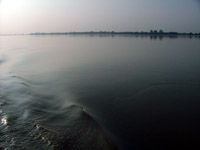
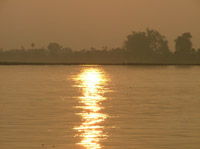
I managed to wake up before my alarm knock, and checked out shortly after five. I said hello to the driver from the previous day's outing (who appeared sober), and he drove me in darkness to the jetty, which was a good distance away. I bought some inedible bananas and a bottle of water, and then boarded, found my seat and settled in. By now I was accustomed to uncomfortable journeys, but I quickly saw that this would not be one of them. The reclining seats were comfortable, and I had lots of legroom. The rest of the passengers got on; they were predominantly foreigners, with just one family from Myanmar on board. The boat was practically empty, and as soon as we pulled away almost everyone leapt up and found a better seat - or a row to lay down on. I stayed in my prime position, and sat up for the sunrise, then took advantage of the newly vacated seats and lay down.

It was a most relaxing day. I lay comfortably, listening to the Hitchhikers' Guide to the Galaxy and dozing on and off. Every so often I would sit up, check out the scenery and take a few shots, and then it was back to snoozing. I felt like I spent the day in bed, but with the added bonus of an interesting and varied view from my bedroom window. A truly civilised way to travel. There was hardly a ripple on the river, and we cruised along at a pleasant speed. We had a couple of stops; at one, frantic women waved colourful tablecloths through the window, and a couple of sales were made. At a quarter to three we were approaching Bagan (at least it was then that I noticed we were near), and temples sprouted from the banks of the river. I stood on the deck watching, a smile spreading on my face - it looked as good as I'd hoped.
Bagan - or Pagan as the British called it - was the most important city in Myanmar from the 11th century AD until the end of the 13-century, when the Mongols invaded. During that time over four thousand temples were built in an area of 40 square kilometres, and well over two thousand remain intact today. By now I was used to seeing a landscape dotted with stupas, but the concentration of temples here is just astounding. Admittedly if you don't like stupas then Bagan may not be the place for you, but I'd challenge anyone not to be impressed by the sheer number of religious buildings here. Some of the temples are massive, architectural feats, with many levels and topped with gold; others are small buildings, housing a single Buddha image. Some are in great shape; many have been restored, either recently or centuries ago; others are a tumbledown pile of bricks. I looked forward to exploring.
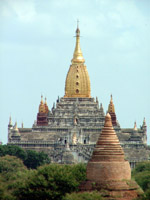
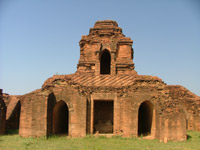
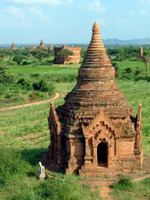
The first thing I had to do was pay the $10 entrance fee at a little table that had been set up near the jetty, then I took a trishaw to the guesthouse I'd selected (because of its proximity to a particularly good sunset temple) a couple of kilometres away. The poor bloke huffed and puffed as he pedalled me and my bag to the place, and I tipped him well. Once I got there, though, I discovered that it was more expensive than I was expecting, or than I was willing to pay. I had another look in the book, and got the trishaw guy to take me another couple of kilometres to Bagan Myothit, or New Bagan. I winced as the sweating cyclist struggled on the uphill sections; he managed to catch his breath enough on the downs to point out some of the better known temples to me.
We arrived at the Kyi Kyi Mya, where I managed to wangle a room for $6, as the air conditioner in it was broken - which suited me. The manager checked the next morning to see if I wanted to swap to an air-con one, but the fan is enough for me. He's a very helpful man and full of information about the temples, tips on good spots for sunset, and other stuff too. He was explaining to me today how the Mon-style temples were designed with small windows and doors, to limit the amount of light that gets in and better preserve the wall paintings inside. It's worked well, as the decorations are visible on a great number of the temples today - although many were touched up in the 19th century. UNESCO were helping to clean up some of the murals, but they pulled out as a protest against the government; no country will sell Myanmar the chemicals needed to continue the restoration work, so the historic artwork has been left to deteriorate.
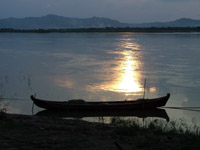
That afternoon I didn't venture too far, just to an active temple nearby (which dates back to 1059AD), and watched the sun set over the Ayeyarwady. I ate at a relatively expensive restaurant, which puts on a marionette show of an evening, accompanied by live music. Traditional Myanmar music is - to my ears at least - a confused mixture of sounds, more like each player independently tuning up their instrument. The food was disappointing, but the show was good. I was given some strange sweets afterwards; I unwrapped one to find a pile of thin discs, which had an unusual taste that I couldn't place - dried apple, maybe? I wasn't sure whether or not I liked them, but ate the plateful trying to find out. It was whilst I was eating them that part of my tooth fell out.
A week before I came away, I suddenly started having excruciating toothache in one of my molars, which recurred intermittently during the first couple of months of my trip. Then a while back a small section of tooth broke off, and from that point on it was fine; at least I had no more pain. Now a large chunk - about a quarter of the tooth - has come away, leaving jagged edges at the back which are sure to rip my cheek - and probably my tongue, as I can't seem to stop playing with it. Fortunately there is no pain, so if I can just hang on until Thailand, I guess I'll have to have it out. Thailand is a popular place to have dental work done, so I can console myself that I'll be saving heaps compared to prices in the UK. I put the piece of tooth under my pillow when I went to bed that night, but it was still there in the morning. I guess the tooth fairy only comes out for whole teeth. Mind you, by the amount of gappy smiles around here, I'm sure that the tooth fairy has a plentiful supply.
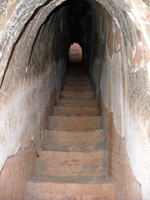
The next morning I hired a bicycle and set off into the countryside. I decided not to plan which temples to visit, but simply to ride around, stopping at any that took my fancy. The first one I stopped at was a pahto - a hollow temple with a Buddha image inside. A man selling paintings showed me the way to climb up to the second floor, the steps leading outside where there were great views. The next temple that caught my eye was a largish chedi (AKA stupa, zedi, paya), a solid, bell-shaped monument. Here there were steps up the outside of the structure, so I went up to see the view from there. I visited some of the major temples and plenty of the minor ones too, ascending whenever I could - seven or eight times in all. The upper levels of some of the biggest temples have now been closed to the general public, so as to preserve the 800 year-old buildings, which is fair enough...though they looked pretty solid to me.
I was still cycling round at midday, proving that I'm either a mad dog or an Englishman, but heat and hunger made me stop within the hour. I continued my explorations afterwards, visiting many more temples. I preferred the smaller sites, where I was the only visitor, save the odd cow grazing outside, or skinny-tailed squirrels that scampered about. My very favourite was a small pahto that I wasn't even able to enter, as it was locked up. It was set in a courtyard planted with flowers and cacti, and surrounding by some attractive zedi. I felt a sense of calm there, and hung out in the shade for a while, enjoying the atmosphere.
I'd read that the hawkers were particularly bad at Bagan, so I'd mentally prepared for them. Whenever anyone started a conversation with me, typically by asking where I was from, I'd reply to their question and add that I didn't want to buy anything, didn't need a guide, and wasn't going to give them any money. I found that in half the cases that did the trick, and the salesperson went back to what they were doing (eating, dozing, chatting with friends); further persuasion I answered with a polite "no thank you". Personally I found the botherations not nearly as bad as at Angkor, although I'm sure things are worse in high season. I couldn't help wonder how some of these people survived - tourists were thin on the ground, and it must be days if not weeks between sales for them.
The most tourists I saw were at sunset. Prime viewing temples are shrinking in number, as the upper terraces of the biggest are being closed to the public. Two months ago climbing was prohibited at Minglazedi, so the favourite now is Shwesandaw Paya, a large, solid monument, with steep steps up the outside. I got up there in plenty of time, and looked down as air-conditioned minibuses pulled up at the foot, sending the hawkers into a flurry of activity. I watched contentedly as the sun began to sink, slipping behind a strip of cloud before it hit the mountains on the horizon. I saw this as a blessing in disguise, as I had four kilometres to cycle home. I climbed down and set off, returning just after dark, with a feeling that I'd had a perfect day.
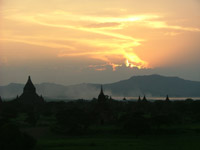
I was up early this morning, as I wanted to see the sunrise. By half-past five I was on my bike, cycling back towards Shwesandaw Paya amidst the sweet scent of flowers, and the chirping of the dawn chorus. The temple wasn't so crowded on this occasion, with only five people up there when I arrived. A dusky pink strip sat on the horizon, and every which way graceful stupas rose out of the morning mist. I felt relaxed as I waited, while the sky became increasingly light. It got so bright that I became convinced that the sun had sneakily slid up, hidden by an unseen cloud. I was pleasantly surprised to spot an orangey-red strip, which grew before my eyes into a fiery disc, misshapen by the atmosphere. I snapped away, though the photos did not do justice to the awesome sight. I seldom see the sun rise, so any time I do manage to get up for it is special, but I don't think I've ever seen one so sublime.
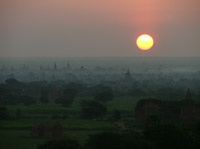
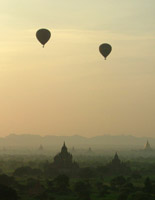
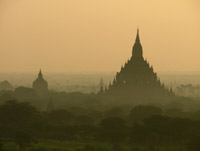
In the distance two hot-air balloons were rising silently into the sky; I envied the occupants. I'd heard that balloon trips cost $150, and had decided to splash out and treat myself. Then I got here and discovered that they were $250, and felt I just couldn't justify the expense for a 45-minute trip. Anyway, I could hardly complain at the sight before my eyes, and consoled myself with the thought that maybe the aerial view wasn't as good; perhaps the angle of elevation would reduce the shrines to two-dimensional squares. I stayed for an hour, taking a ridiculous amount of pictures - thank goodness for digital! I descended just before seven, and set off to explore nearby Dhammayanghi Pahto, one of the biggest temples. I walked alone through dark, dank passages, where the fusty smell of bat shit irritated my nostrils. The bats squeaked at each other as they settled down to sleep, while the pigeons cooed good morning to one another.
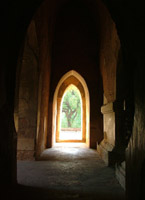
I stopped for breakfast around nine, calling in at a little tea shop for tea - both types - and something called a bladder, or at least that's what it sounded like. The name quite put me off until I saw it - it was sort of similar to a big, puffy popadom, with a pile of dahl heaped in the middle, and it tasted delicious. The food revived me for a while, but by half-past ten I decided to pop back to the room for a bit of a kip. Unfortunately the electricity was off, and without the fan it was too hot to sleep. I waited in vain for it to come on, but it didn't, instead I got more hot, tired, and irritable. Eventually I gave up and went out for a late lunch at a cheap restaurant in town. My veggie noodles were rounded off with a plate of la-hpeq thouq, oily tea leaves, sesame seeds and peanuts, which was strange, but tasty.
After I'd eaten it was back to the temples, although my enthusiasm had waned somewhat due to tiredness and a flat tyre, though I was able to get the latter pumped up without too much difficulty - flats are common here. I went to a temple suggested by the manager of the guesthouse to watch the sunset, but a bank of clouds sat in place to obscure it again. I enjoyed the view for a while, and watched the squirrels running around, then headed back. I plan to see some more temples tomorrow, and maybe go for a swim in one of the hotel pools, which you can do for a price. On Saturday I've arranged for an outing to Mount Popa, which I'm hoping will be enjoyable. I'll be leaving on Sunday, destined for Lake Inle. Transportation is by pick-up, and they leave at the ludicrously early time of three thirty in the morning. God knows why, there's no need for it that I can see. I expect to spend the whole of Sunday scowling...that's if I'm not vomiting, as the road is said to be horribly windy.
 Visit SerenityPhotography.co.uk, where you can buy beautiful pictures from around the world...all taken by yours truly! |